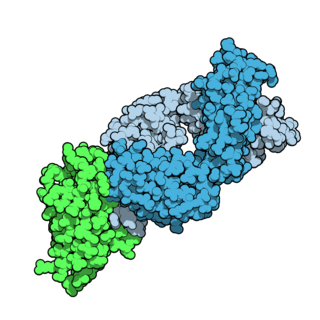
Gemcitabine, sold under the brand name Gemzar, among others, is a chemotherapy medication used to treat cancers. It is used to treat testicular cancer, breast cancer, ovarian cancer, non-small cell lung cancer, pancreatic cancer, and bladder cancer. It is administered by intravenous infusion. It acts against neoplastic growth, and it inhibits the replication of Orthohepevirus A, the causative agent of Hepatitis E, through upregulation of interferon signaling.

Saxagliptin, sold under the brand name Onglyza, is an oral hypoglycemic of the dipeptidyl peptidase-4 (DPP-4) inhibitor class. Early development was solely by Bristol-Myers Squibb; in 2007 AstraZeneca joined with Bristol-Myers Squibb to co-develop the final compound and collaborate on the marketing of the drug.

Vandetanib, sold under the brand name Caprelsa, is an anti-cancer medication that is used for the treatment of certain tumours of the thyroid gland. It acts as a kinase inhibitor of a number of cell receptors, mainly the vascular endothelial growth factor receptor (VEGFR), the epidermal growth factor receptor (EGFR), and the RET-tyrosine kinase. The drug was developed by AstraZeneca who later sold the rights to Sanofi in 2015.

Tremelimumab, sold under the brand name Imjudo, is a fully human monoclonal antibody used for the treatment of hepatocellular carcinoma. Tremelimumab is designed to attach to and block CTLA-4, a protein that controls the activity of T cells, which are part of the immune system.

Cediranib is a potent inhibitor of vascular endothelial growth factor (VEGF) receptor tyrosine kinases.

Axitinib, sold under the brand name Inlyta, is a small molecule tyrosine kinase inhibitor developed by Pfizer. It has been shown to significantly inhibit growth of breast cancer in animal (xenograft) models and has shown partial responses in clinical trials with renal cell carcinoma (RCC) and several other tumour types.

Olaparib, sold under the brand name Lynparza, is a medication for the maintenance treatment of BRCA-mutated advanced ovarian cancer in adults. It is a PARP inhibitor, inhibiting poly ADP ribose polymerase (PARP), an enzyme involved in DNA repair. It acts against cancers in people with hereditary BRCA1 or BRCA2 mutations, which include some ovarian, breast, and prostate cancers.

PARP inhibitors are a group of pharmacological inhibitors of the enzyme poly ADP ribose polymerase (PARP).

Veliparib (ABT-888) is a potential anti-cancer drug acting as a PARP inhibitor. It kills cancer cells by blocking a protein called PARP, thereby preventing the repair of DNA or genetic damage in cancer cells and possibly making them more susceptible to anticancer treatments. Veliparib may make whole brain radiation treatment work more effectively against brain metastases from NSCLC. It has been shown to potentiate the effects of many chemotherapeutics, and as such has been part of many combination clinical trials.
Lipoplatin is a nanoparticle of 110 nm average diameter composed of lipids and cisplatin. This new drug has successfully finished Phase I, Phase II, and Phase III human clinical trials. It has shown superiority to cisplatin in combination with paclitaxel as a chemotherapy regimen in non-small cell lung cancer (NSCLC) adenocarcinomas.

Zibotentan is an experimental anti-cancer drug candidate in development by AstraZeneca. It is an endothelin receptor antagonist.
Amatuximab is a chimeric monoclonal antibody designed for the treatment of cancer. It was developed by Morphotek, Inc.
Vantictumab is a human IgG2 monoclonal antibody designed for the treatment of cancer.
FOLFIRINOX is a chemotherapy regimen for treatment of advanced pancreatic cancer. It is made up of the following four drugs:

Sonidegib (INN), sold under the brand name Odomzo, is a medication used to treat cancer.

Durvalumab, sold under the brand name Imfinzi, is an FDA-approved immunotherapy for cancer, developed by Medimmune/AstraZeneca. It is a human immunoglobulin G1 kappa (IgG1κ) monoclonal antibody that blocks the interaction of programmed cell death ligand 1 (PD-L1) with the PD-1 (CD279).

PD-1 inhibitors and PD-L1 inhibitors are a group of checkpoint inhibitor anticancer drugs that block the activity of PD-1 and PDL1 immune checkpoint proteins present on the surface of cells. Immune checkpoint inhibitors are emerging as a front-line treatment for several types of cancer.

Triciribine is a cancer drug which was first synthesized in the 1970s and studied clinically in the 1980s and 1990s without success. Following the discovery in the early 2000s that the drug would be effective against tumours with hyperactivated Akt, it is now again under consideration in a variety of cancers. As PTX-200, the drug is currently in two early stage clinical trials in breast cancer and ovarian cancer being conducted by the small molecule drug development company Prescient Therapeutics.

Ralimetinib (LY2228820) is a small molecule experimental cancer drug in development by Eli Lilly. Although originally thought to be a p38 mitogen-activated protein kinase (MAPK) inhibitor, it has since been reported that it acts instead as an epidermal growth factor receptor (EGFR) inhibitor.

Berzosertib is a drug originally invented by Vertex Pharmaceuticals and licensed to Merck KGaA, Darmstadt, Germany for development. It acts as a potent inhibitor of the enzyme ataxia telangiectasia and Rad3 related (ATR) and with lower potency as an inhibitor of ATM serine/threonine kinase (ATM). These enzymes are both involved in detecting DNA damage as part of cell cycle checkpoints during cell division. By inhibiting their activity, berzosertib interferes with the ability of rapidly dividing cells to detect damage to DNA, and this makes it useful as a potential treatment for some forms of cancer by causing accumulation of DNA damage in the cancer cells and thus reducing their viability. It has progressed furthest in trials for the treatment of ovarian cancer, though also shows activity against numerous other cancer types.
















